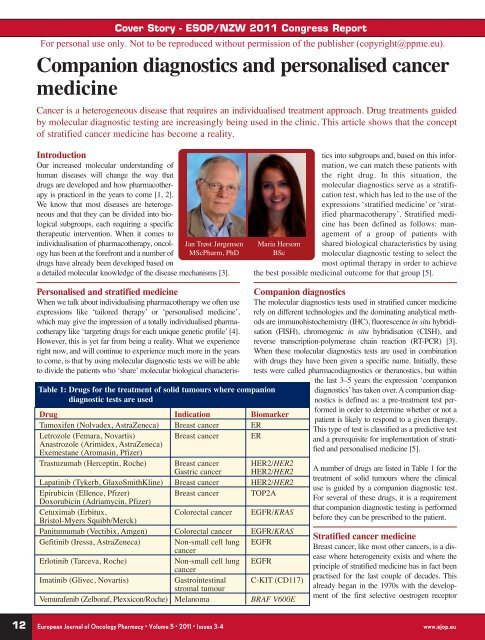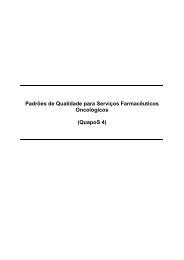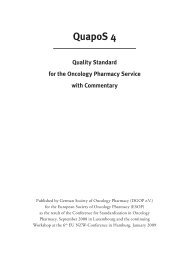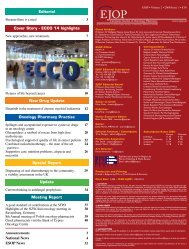Editorial Cover Story ESOP/NZW 2011 Congress Report Oncology ...
Editorial Cover Story ESOP/NZW 2011 Congress Report Oncology ...
Editorial Cover Story ESOP/NZW 2011 Congress Report Oncology ...
You also want an ePaper? Increase the reach of your titles
YUMPU automatically turns print PDFs into web optimized ePapers that Google loves.
<strong>Cover</strong> <strong>Story</strong> - <strong>ESOP</strong>/<strong>NZW</strong> <strong>2011</strong> <strong>Congress</strong> <strong>Report</strong><br />
For personal use only. Not to be reproduced without permission of the publisher (copyright@ppme.eu).<br />
Companion diagnostics and personalised cancer<br />
medicine<br />
Cancer is a heterogeneous disease that requires an individualised treatment approach. Drug treatments guided<br />
by molecular diagnostic testing are increasingly being used in the clinic. This article shows that the concept<br />
of stratified cancer medicine has become a reality.<br />
Introduction<br />
Our increased molecular understanding of<br />
human diseases will change the way that<br />
drugs are developed and how pharmacotherapy<br />
is practiced in the years to come [1, 2].<br />
We know that most diseases are heterogeneous<br />
and that they can be divided into biological<br />
subgroups, each requiring a specific<br />
therapeutic intervention. When it comes to<br />
individualisation of pharmacotherapy, oncol- Jan Trøst Jørgensen<br />
ogy has been at the forefront and a number of MScPharm, PhD<br />
drugs have already been developed based on<br />
a detailed molecular knowledge of the disease mechanisms [3].<br />
Personalised and stratified medicine<br />
When we talk about individualising pharmacotherapy we often use<br />
expressions like ‘tailored therapy’ or ‘personalised medicine’,<br />
which may give the impression of a totally individualised pharmacotherapy<br />
like ‘targeting drugs for each unique genetic profile’ [4].<br />
However, this is yet far from being a reality. What we experience<br />
right now, and will continue to experience much more in the years<br />
to come, is that by using molecular diagnostic tests we will be able<br />
to divide the patients who ‘share’ molecular biological characteris-<br />
Table 1: Drugs for the treatment of solid tumours where companion<br />
diagnostic tests are used<br />
Maria Hersom<br />
BSc<br />
Drug Indication Biomarker<br />
Tamoxifen (Nolvadex, AstraZeneca) Breast cancer ER<br />
Letrozole (Femara, Novartis) Breast cancer ER<br />
Anastrozole (Arimidex, AstraZeneca)<br />
Exemestane (Aromasin, Pfizer)<br />
Trastuzumab (Herceptin, Roche) Breast cancer HER2/HER2<br />
Gastric cancer HER2/HER2<br />
Lapatinib (Tykerb, GlaxoSmithKline) Breast cancer HER2/HER2<br />
Epirubicin (Ellence, Pfizer) Breast cancer TOP2A<br />
Doxorubicin (Adriamycin, Pfizer)<br />
Cetuximab (Erbitux, Colorectal cancer EGFR/KRAS<br />
Bristol-Myers Squibb/Merck)<br />
Panitumumab (Vectibix, Amgen) Colorectal cancer EGFR/KRAS<br />
Gefitinib (Iressa, AstraZeneca) Non-small cell lung EGFR<br />
cancer<br />
Erlotinib (Tarceva, Roche) Non-small cell lung EGFR<br />
cancer<br />
Imatinib (Glivec, Novartis) Gastrointestinal C-KIT (CD117)<br />
stromal tumour<br />
Vemurafenib (Zelboraf, Plexxicon/Roche) Melanoma BRAF V600E<br />
tics into subgroups and, based on this information,<br />
we can match these patients with<br />
the right drug. In this situation, the<br />
molecular diagnostics serve as a stratification<br />
test, which has led to the use of the<br />
expressions ‘stratified medicine’ or ‘stratified<br />
pharmacotherapy’. Stratified medicine<br />
has been defined as follows: management<br />
of a group of patients with<br />
shared biological characteristics by using<br />
molecular diagnostic testing to select the<br />
most optimal therapy in order to achieve<br />
the best possible medicinal outcome for that group [5].<br />
Companion diagnostics<br />
The molecular diagnostics tests used in stratified cancer medicine<br />
rely on different technologies and the dominating analytical methods<br />
are immunohistochemistry (IHC), fluorescence in situ hybridisation<br />
(FISH), chromogenic in situ hybridisation (CISH), and<br />
reverse transcription-polymerase chain reaction (RT-PCR) [3].<br />
When these molecular diagnostics tests are used in combination<br />
with drugs they have been given a specific name. Initially, these<br />
tests were called pharmacodiagnostics or theranostics, but within<br />
the last 3–5 years the expression ‘companion<br />
diagnostics’ has taken over. A companion diagnostics<br />
is defined as: a pre-treatment test performed<br />
in order to determine whether or not a<br />
patient is likely to respond to a given therapy.<br />
This type of test is classified as a predictive test<br />
and a prerequisite for implementation of stratified<br />
and personalised medicine [5].<br />
A number of drugs are listed in Table 1 for the<br />
treatment of solid tumours where the clinical<br />
use is guided by a companion diagnostic test.<br />
For several of these drugs, it is a requirement<br />
that companion diagnostic testing is performed<br />
before they can be prescribed to the patient.<br />
Stratified cancer medicine<br />
Breast cancer, like most other cancers, is a disease<br />
where heterogeneity exists and where the<br />
principle of stratified medicine has in fact been<br />
practised for the last couple of decades. This<br />
already began in the 1970s with the development<br />
of the first selective oestrogen receptor<br />
12 European Journal of <strong>Oncology</strong> Pharmacy • Volume 5 • <strong>2011</strong> • Issues 3-4 www.ejop.eu










